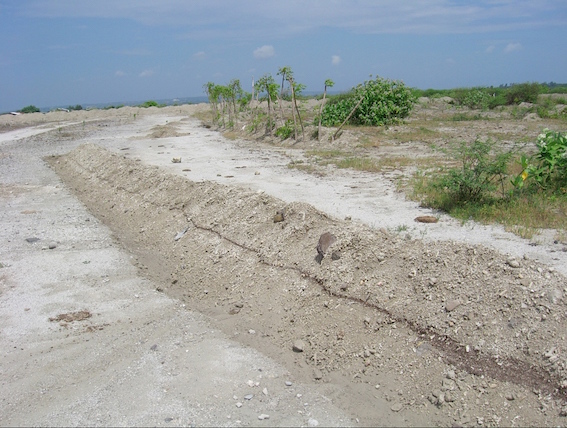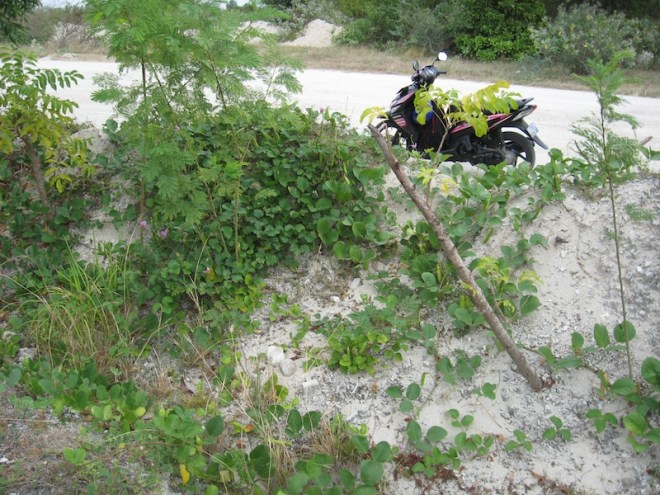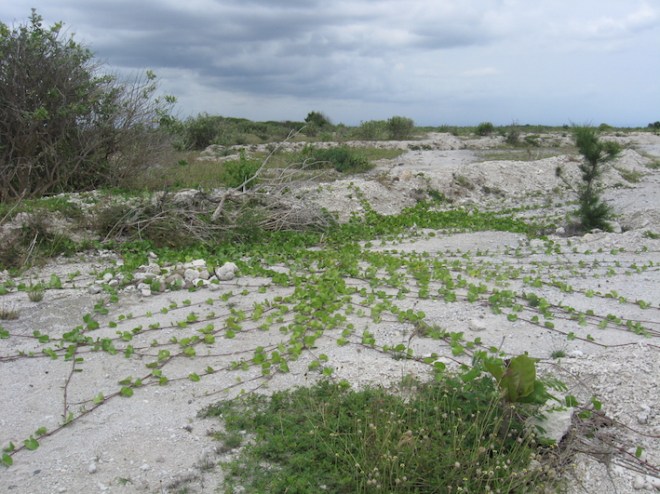When I first started working/playing with my land in northern New South Wales, fresh from my first workshop in Permaculture with Bill Mollison and Tony (Gehan) Gilfedder, I knew nothing, but was armed at least with the enthusiasm of the vision inspired by Bill’s approach, and the shining example of Tony and Lena’s transformation of a wasted ex-banana plantation into the sheer abundance of a sub-tropical polyculture paradise.
One of the first things that struck me was the simplicity of creating a very complex ecosystem. As Bill has said: “The productivity of a human-designed ecosystem is theoretically almost unlimited.” The greatest limitation is the imagination and capacity of people to recognise and implement naturally occurring processes: observation, deduction, and application.
Here is one shining example, which dramatically illustrates the potential:
Indonesia: Serangan – Turtle Island – is a small island detached from the mother island of Bali by only a channel of water. When the main port harbour of Bali was deepened, the resulting material of sand and coral was added to the smaller island to form an effective breakwater against the fury of the Indian Ocean in stormy weather. The resulting 600+ hectares of land only very thinly regenerated in the first 20 years.

I was contacted to regenerate the barren wasteland of a few hundred hectares where virtually nothing had happened , apart from tufted low grasses sparsely scattered. The surface was like concrete, and although it seemed almost perfectly flat, I was convinced that vast amounts of water must run off every year on that impervious plain, to be lost in the ocean.
From my studies stimulated through Permaculture, I felt that there would be a fresh water lens under the surface. The island ‘peaked’ at barely 8 metres above sea level but a bore confirmed brackish sweet water at slightly over 6 metres depth.

We found brackish water (slightly salty) at 6.5 metres – just 1.5 metres above sea level
Having carefully patterned the area with a laser level, I had an excavator create rough (but perfectly horizontal) swales, overlapped to ensure that not a drop could be lost to the extent possible. After one evening of thunderstorms, this was the result:

After one thunderstorm event: soil and organic material deposited where there there seemed to be none.
Looking around, it’s easy to find vegetation that actually grows in such harsh conditions, even when it seems to be only sand and coral, as hard as concrete. There are always niches, such as small hollows in an almost flat landscape. In such places, seeds are deposited, wind-carried or rain-driven organic material collects; germination takes place with the species able to survive and grow, even in harsh conditions: a succession of regeneration begins.
Taking careful observation of all the species which grow in similar conditons, the selection of plants to use becomes obvious. Creating niches to encourage the growth accelerates the process rapidly. Groundcovers are vitally important, creating conditions of shade and lower temperatures to improve the conditions for the shrub and tree species, and providing new microclimates for a greater variety of species. Birds and insects and animals have food sources to encourage their arrival, and they bring more diversity and fertility as they feed and defecate.
The root action now opens up the soil further, so that more water is absorbed into the soil, carrying whatever dust and other organic material, creating soil quality which could not exist before. The whole desolate landscape begins to transform.
Wherever we plant one tree or shrub, we plant several companions, especially legumes and groundcover species, to add to the biomass and create an ‘oasis’ of abundance in the desert that surrounds. Now the action can really begin to explode.

Planting guilds – never solitary species
These guilds have ‘intelligence’; they ‘seek’ water, following it down as the top layers dry out, providing a fertile welcome for any other seeds, attracting wildlife which add to the fertily as well as depositing more seeds, greater diversity. These begin to join up with other ‘oases’. Regeneration gathers pace.
 Now the environment has completely transformed
Now the environment has completely transformed
 A forest begins from the desert
A forest begins from the desert
The need for planting rapidly decreases as the new species arrive to occupy ever-newer niches. A geometric growth succession takes place as soil multiplies, becomes more sponge-like, moisture is held, the temperature stabilises, atmosphere more humid and welcoming.

The water table has risen dramatically, by as much as three metres; roots have three metres less to seek a constant source of fresh water, and all the while, the increasing root matrix holds more water, more nutrients.
The whole ‘wasteland has become one vast network; a single organism. We should never plant single trees or shrubs. Group plantings become companions. Companions become oases. Oases join to become clusters, and the clusters unite to become a forest. Imagine this multiplied across the whole planet: the effect on the climate; the moderation of extremes; the storage water and nutrient; the availability of food, shelter, resources, activity, employment. Life quality for all beings.

This metamorphosis is in a monsoon tropical environment, with high humidity, hot and alternately very wet and very dry. Soil can be created, from nothing, at a very low energetic or financial cost. Biomass is the key to fertility creation and maintenance. The air we breathe is almost 80% nitrogen, one of the key building blocks for vegetal growth.
This transformation is very easily possible over a vast area of many millions of hectares of ‘wasteland’. Soil is not necessary, since it is biomass and niches for water and organic material to deposit and expand. We can very significantly accelerate the natural processes, simply by following the natural processes and examples which we find everywhere. Observation is the key, and sensitive deduction from the patterns which reveal themselves.
In more temperate climates, the dynamics are different: the soil quality is more important, soil creation slower, fertily creation is more important, through creating and providing composts, manures, fermentation processes to accelerate regeneration. However, the basic principles are same: Observe, deduce, respond, as active participants and accelerators of Nature’s abundance.
.

I wonder why you don’t mention that the island was not a ‘barren island’ until govt /corporate tourist ‘development’ buried it in excavated sand/coral around circa 2015. So your claim that “The resulting 600+ hectares of land only very thinly regenerated in the first 20 years.” can’t be true can it? As anyone can see here:
http://www.kutabackpacker.com/2011/02/serangan-island.html
http://www.balisurfwaves.com/serangan/
https://coconuts.co/bali/news/watch-benoa-reclamation-oh-please-not-another-serangan/
I wonder who funded your works?
Greetings Keith, I’m very sorry that I hadn’t responded to your comment, but only now have I ‘found’ it, and a number of other comments; zero attention to them for several years. The others needed no responses, but I was embarrassed to find yours neglected.
I was invited around 2008 by Bali Turtle Island Corporation to regenerate the ocean-side land behind the huts and warungs; I was told at the time that it had been dredged and added to the existing island around 15 years earlier, and in that time very little had grown over around 200 hectares which had been added to the ‘original’ island. I was told that the total area eventually to be regenerated was around 600 hectares; this may have been the total area of island at that time. The area I worked with was the south east side of the island.
You seem to be quite aggressively accusing me of something. I was regenerating land that already had a very questionable history. It seemed to be destined for some sort of ‘beautiful Bali’ development project. I suggested that to the ‘owner’ of that land, Cherie Nursalim, and she was enthusiastic to my suggestion that it could be a model for a truly sustainable development which could be done specifically with the existing residents of the original island. I was still dubious of its chances, but in doing the project I would have a better chance (however small) of having a positive influence on outcome. It was going to be developed obviously, and I trust my own capacity to create a better outcome than most. If that turned out to be the case, I suggest that it would have happened with or without me. As an environmental activist and project designer of over 30 years, that’s been my experience.
However, my claim that 2008 was the year I was working there is absolutely true and the transformation that I recorded in my photos is completely genuine, and your implication that it is not is simply untrue and I can prove it. I suggest that you recheck your timelines. I have a lot of photo documentation of the time I was there and would be happy to send it if that would be useful.
Please, I am sure your intentions are absolutely good, but that suggestion is not accurate; I haven’t been to Bali since around 2010, but I had a letter from John Hardy in 2012 saying that my regeneration work had been spectacularly successful.
My conscience is clear that my work was good. What happened afterwards is very likely otherwise, like so much of the development of Bali.
I wish you well,
John Button
John
you are correct re the dates of the ‘reclamation work’:
https://coconuts.co/bali/news/watch-benoa-reclamation-oh-please-not-another-serangan/
“South Bali’s first reclamation in the 90s left us with something of a wasteland, destroying the environment’s coral, mangroves, and turtle population”
and:
https://coconuts.co/bali/features/development-bali-serangan/
“The island was the site of South Bali’s first reclamation project in 1998. It left us with something of a wasteland, wreaking havoc on the environment’s coral, mangroves, and turtle population. The touted vision was that of a booming hot spot of hotels, a fresh new dynamic tourist destination.
It looked pretty amazing in the sketches; what we got was an entirely different story.”
Still 1998 to 2008 is not 20 years and the Bali Turtle Island Corporation is undoubtedly the same entity as the the one mentioned in the above article; Cherie Nursalim is Vice Chairman of GITI -the developer
http://kurakurabali.com/who-we-are/
When I wrote “I wonder who funded your works?” I was not aware of any of this but it seems my suspicions were not unfounded. I find it hard to believe that all this was unknown to you and I don’t see any difference between your ‘corporate’ publicity and Giti’s bull. Your article is misleading as much in what is omitted as what is claimed to quote “If there’s any lesson we can learn from the past, it’s that these projects often run out of money, encounter corruption, fall desperately short of the conceptualizations, and all-too-often harm the environment.”
Your desert seems to have been a good example of this and not an inevitable result; clearly Giti’s ‘masterplan’ is an afterthought
I don’t have any bones to pick with you, and I’m not sure what motivates you in this communication. I said that I was doubtful about the motives for ‘prettying up’ the site (I was told that the dredging had been 15 or 20 years, and there was no reason for me to check precisely the historical timeline. The land was virtually barren, and I was asked if I could accelerate the regeneration process. I could and did. I gave my opinion on the potential for creating a very different development model than the ‘normal’ ones, including drafting a plan that included a vastly improved animal husbandry system for the cattle being free-grazed by the locals from the village, and the encouragement that by including at the locals in the design process, a mutually beneficial outcome could be achieved for all. I don’t have any argument with your commentary on the frequent outcomes of such projects. I did my best to influence a different outcome, and doubt if the opportunity will come again. I voiced my doubts, both in this thread, and to Cherie Nursalim originally, so I’ll not bother with your snide ‘corporate’ publicity inference; I have probably done more than you would care to recognise by way of successful activism. I did good work there, and certainly set up an example of accelerated regeneration, that can obviously be used for better, or for worse. I’m sure there are plenty of development projects still going on there (I’ve not been back for 9 or 10 years, preferring to avoid tourist traps and ex-pat communities) in which there may be plenty of scope for activists to put their attention to influencing. I wish you well, and support your intentions of shining light on dubious development.
Ah, Keith, I notice now that actually I’m very prompt in responding, and that your letter was only a few days ago. My response to you is all still valid anyway. Thanks for the links, especially the last, which confirms my doubts of 11 years ago. My proposal for what kind of development was possible that may help to create a situation compatible with the existing community and the ecological fragility remain in my opinion, a better option than otherwise. The dredging was done by Tommy Suharto in the early 90s